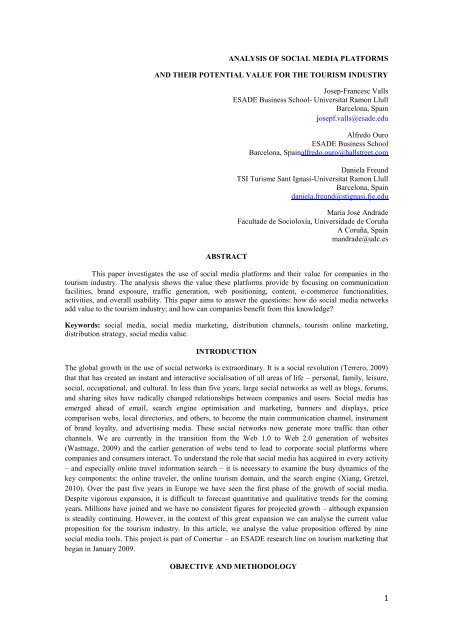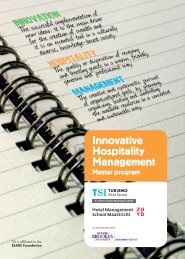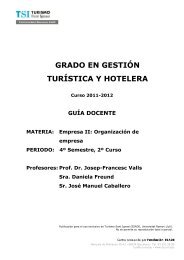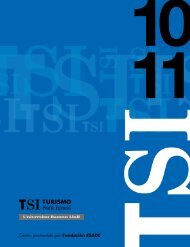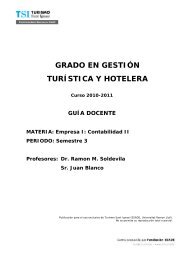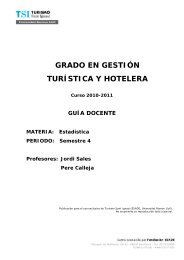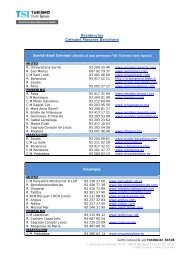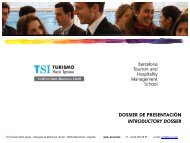ANALYSIS OF SOCIAL MEDIA PLATFORMS AND THEIR ...
ANALYSIS OF SOCIAL MEDIA PLATFORMS AND THEIR ...
ANALYSIS OF SOCIAL MEDIA PLATFORMS AND THEIR ...
You also want an ePaper? Increase the reach of your titles
YUMPU automatically turns print PDFs into web optimized ePapers that Google loves.
<strong>ANALYSIS</strong> <strong>OF</strong> <strong>SOCIAL</strong> <strong>MEDIA</strong> <strong>PLATFORMS</strong><br />
<strong>AND</strong> <strong>THEIR</strong> POTENTIAL VALUE FOR THE TOURISM INDUSTRY<br />
ABSTRACT<br />
Josep-Francesc Valls<br />
ESADE Business School- Universitat Ramon Llull<br />
Barcelona, Spain<br />
josepf.valls@esade.edu<br />
Alfredo Ouro<br />
ESADE Business School<br />
Barcelona, Spainalfredo.ouro@hallstreet.com<br />
Daniela Freund<br />
TSI Turisme Sant Ignasi-Universitat Ramon Llull<br />
Barcelona, Spain<br />
daniela.freund@stignasi.fje.edu<br />
María José Andrade<br />
Facultade de Socioloxía, Universidade de Coruña<br />
A Coruña, Spain<br />
mandrade@udc.es<br />
This paper investigates the use of social media platforms and their value for companies in the<br />
tourism industry. The analysis shows the value these platforms provide by focusing on communication<br />
facilities, brand exposure, traffic generation, web positioning, content, e-commerce functionalities,<br />
activities, and overall usability. This paper aims to answer the questions: how do social media networks<br />
add value to the tourism industry; and how can companies benefit from this knowledge?<br />
Keywords: social media, social media marketing, distribution channels, tourism online marketing,<br />
distribution strategy, social media value.<br />
INTRODUCTION<br />
The global growth in the use of social networks is extraordinary. It is a social revolution (Terrero, 2009)<br />
that that has created an instant and interactive socialisation of all areas of life – personal, family, leisure,<br />
social, occupational, and cultural. In less than five years, large social networks as well as blogs, forums,<br />
and sharing sites have radically changed relationships between companies and users. Social media has<br />
emerged ahead of email, search engine optimisation and marketing, banners and displays, price<br />
comparison webs, local directories, and others, to become the main communication channel, instrument<br />
of brand loyalty, and advertising media. These social networks now generate more traffic than other<br />
channels. We are currently in the transition from the Web 1.0 to Web 2.0 generation of websites<br />
(Wastnage, 2009) and the earlier generation of webs tend to lead to corporate social platforms where<br />
companies and consumers interact. To understand the role that social media has acquired in every activity<br />
– and especially online travel information search – it is necessary to examine the busy dynamics of the<br />
key components: the online traveler, the online tourism domain, and the search engine (Xiang, Gretzel,<br />
2010). Over the past five years in Europe we have seen the first phase of the growth of social media.<br />
Despite vigorous expansion, it is difficult to forecast quantitative and qualitative trends for the coming<br />
years. Millions have joined and we have no consistent figures for projected growth – although expansion<br />
is steadily continuing. However, in the context of this great expansion we can analyse the current value<br />
proposition for the tourism industry. In this article, we analyse the value proposition offered by nine<br />
social media tools. This project is part of Comertur – an ESADE research line on tourism marketing that<br />
began in January 2009.<br />
OBJECTIVE <strong>AND</strong> METHODOLOGY<br />
1
An instrument for measuring the factors that influence the importance of the Web 2.0 in the tourism<br />
industry has been designed from an established framework. The initial list of factors for analysis had its<br />
origin in a series of focus groups with experts (all of whom were related to the tourism sector) in e-<br />
business, new technology, and quantitative methods. The tool was revised and tested on a small group of<br />
tourism firms. The final validation of the tool was performed using the ‘Gartner Web Evaluation Tool’<br />
and it is being used for the first time in this fieldwork.<br />
This study evaluates the strategic usefulness of Web 2.0 tools (including social networking sites,<br />
blogs, microblogs, forums, aggregators, wikis, and sharing webs) for tourism firms through a comparative<br />
analysis of various aspects and the value that each brings. In terms of methodology, we firstly use<br />
secondary sources; then we conduct a series of in-depth interviews; and thirdly, we conduct fieldwork<br />
using a sample of 587 type-2.0 websites. The sample is composed of: 422 blogs (top international 100<br />
from Technorati; top international 100 from Technorati travel section; top 100 from Alianzo in Spanish;<br />
and top 100 from travel section of Alianzo in Spanish. In addition, 22 microblogs were added (from<br />
Overdrive Interactive); 70 social networks (top ranked in Rank.loogic.com – Hispanic section social<br />
networks); 30 forums and aggregators (top rated in Rank.loogic.com – aggregators section); 55 sharing<br />
webs from a variety of sources (Alianzo, Overdrive Interactive, and Fundación Orange). These sites were<br />
distributed as follows: 14 photo-sites, 20 book-marking webs, 16 video-sites, 5 podcasts; and 10 wikis<br />
(top 10 from Alexa and Google PageRank – source ValueWiki.com). Three dimensions are examined:<br />
value for corporate strategy; value for the tourism industry; and a general assessment. We identified four<br />
levels for corporate strategy: customer communication; brand exposure; traffic generation; and natural<br />
web positioning – which is broken down into 26 aspects. We identified five value levels for the tourism<br />
industry: content; e-commerce; social activity; stage of activity (pre-purchase/ purchase and consumption/<br />
post-consumption); and business-level utility (broken down into 21 aspects). The designed analysis tool<br />
(see Appendix) takes into account the recommendations of the experts interviewed; as well as the results<br />
of the AIMC survey that detailed the preferences of Spanish users when navigating social networks,<br />
blogs, and content (AIMC, 2010). Each of these aspects is valued from 1 to 5 (none being 1) and the<br />
results are weighted. The analysis period lasted 60 days from 09.02.10.<br />
STATE <strong>OF</strong> THE ART <strong>OF</strong> <strong>SOCIAL</strong> NETWORKS<br />
From 2000 to 2011, e-commerce in the United States grew from 1.2% to 4.6% of total retail sales.<br />
Growth during the same period in Europe was 275% and reached 3.5% of global retail sales. In Spain,<br />
sales have increased sevenfold since 2004 and now account for 3.5% of total sales – the same level as in<br />
the rest of Europe. Because of its newness, e-commerce remains a small percentage of total retail volume<br />
– yet despite the impact of the economic crisis unleashed in 2008 e-commerce shows extraordinary<br />
growth that is projected to continue (Correos, 2011). Among the most important areas of on-line activity<br />
in Spain are travel agencies and tour operators, air transport, direct marketing, land passenger transport,<br />
gaming and gambling, live and sports entertainment, education, clothing, advertising, computers and<br />
software (Correos, 2011). Travel, accommodation, leisure and entertainment, package holidays, and car<br />
rental represent 37.8% of total on-line transactions (AIMC, 2010). The impact of on-line sales in tourism<br />
has caused a radical change in the value chain and distribution of travel products (O’Connor, Frew,<br />
2000); and has generated a new concept of knowledge: “people search, find, read, gather, share, develop<br />
and consume information, as well as in the way people communicate with each other and collaboratively<br />
create new knowledge… The tourism industry is not an exception to such developments. On the contrary,<br />
as information is the lifeblood of tourism, the use and diffusion of Web 2.0 technologies have a<br />
substantial impact on tourism demand and supply,” (Sigala, 2010a: 221). “Tourism is one of the highest<br />
involvement industries, which means potential tourists want to get as much knowledge as they can to<br />
reduce the risk,” (Chung, Buhalis, 2008: 278). Online communities are focuses for multidisciplinary<br />
interests from the perspectives of sociology, technology, the virtual world, and e-commerce (Preece,<br />
2000). Some players are losing ground, while others, especially those linked with communications<br />
technology, are gaining ground. “Today’s customers are more inclined to listen to suggestions and<br />
opinions from friends and relatives than listen to intrusive, commercial, company-driven communication.<br />
In this regard social media have become aggregators of content and mediators of human relationships.<br />
Therefore, the tourist becomes the major source of raw experiential data input and the cognitive engine<br />
that translates the experiential data into meaning, and also, thanks to social media, tourists become the<br />
control center for information distribution and use,” (Volo,2012:24).<br />
2
The bargaining power that in the early days of mass tourism in the 1960s was completely in the<br />
hands of the wholesalers (tour operators and traditional travel agencies) is sliding towards producers and<br />
customers. The arrival of Web 1.0 changed the purchasing behaviour of tourists and their relationship<br />
with suppliers at the expense of traditional wholesalers. The emergence of social networks and the<br />
penetration of Web 2.0 has further accelerated this trend. ‘There has been a fundamental shift in<br />
consumer behaviour on the web over the last five years as consumers have become more expressive and<br />
willing to share personal information online. This change has led to the development of social media,’<br />
(Correos, 2011:7). Social networks are accelerating the penetration of internet. When planning their<br />
vacations, some 58% of English consumers are influenced by social networks (Eyefortravel, 2011a). The<br />
net will grow even more in the near future as mobile phones, customer relationship management<br />
strategies, and algorithmic formulas are integrated. Consumers and employees will increasingly become<br />
marketing teams for companies (Eyefortravel, 2011b). Social media influences the planning of trips and is<br />
also a factor during consumption and post-consumption. Throughout the travel cycle, travellers<br />
increasingly expect information to be readily available (Gupta, 2011). There are two sources of<br />
explanations for the growth of social networks – one of which is internal and the other external to the<br />
search for a direct relationship between businesses and consumers. The internal reasons include: the<br />
radical simplification of the value chain; reducing consumer prices; reducing the cost of customer<br />
acquisition and thereby increasing the life-value of the client; minimisation of marketing and transport<br />
costs; and quicker contact with the target audience. “The popularity and credibility of online travel<br />
communities is due to their providing trustworthy reviews and recommendations (Chung, Buhalis, 2008:<br />
272) The external reasons include: generation of website traffic; gathering of opinions and suggestions<br />
made by customers and potential buyers; direct participation in the creation of a brand experience; brand<br />
protection; and reputation enhancement.<br />
European tourism companies are quickly adapting and looking for the most efficient way to use this<br />
media. Many firms are attempting to go beyond simply optimising their natural positioning in search<br />
engines and aim to take advantage of the opportunities offered by ‘viral’ marketing. “Nowadays, the<br />
majority of tourists prefer and demand to design and book personalized tourism packages and trip<br />
itineraries. This trend is heavily demonstrated by the huge customer take-up of dynamic packaging<br />
services offered by several cyber intermediaries. However, trip planning is a very complex process<br />
requiring travellers to identify, filter, evaluate, and select a massive amount of information,” (Sigala,<br />
2010b: 418). Robertson cautions firms about launching themselves on the net before defining a clear<br />
strategy: ‘Companies should be wary of jumping on the latest technology bandwagons simply for the sake<br />
of it and should instead have a strategy to ensure they work for them,’ (Robertson, 2010:21). However,<br />
the internet may be the only path that leads to competitiveness and businesses growth. ‘Web 2.0 is largely<br />
about relationships and using technologies that try to foster a connection between a company and the<br />
potential holidaymaker – part of this is social media – in many ways the consumer increasingly decides<br />
what you are about and tells others online,’ (Easen, 2009:48). The internet replicates real-life contacts,<br />
destroys the concept of proximity and direct physical knowledge, while providing contact with people<br />
who have relevant experience. “Tourism experiences are well suited to be told in a narrative form<br />
accompanied by pictures and videos – and blogs are an almost natural means of communication in<br />
today’s technological worlds (Volo, 2012: 34). In this way, “many travel and tourism operations have<br />
also recognized the importance of including consumer-generated content on their websites, usually in the<br />
form of edited testimonials,” (Xiang, Gretzel, 2010: 180). This approach enables everyone to gain<br />
universal exposure, facilitates corporate credibility and reputation, and helps to cut the costs of marketing<br />
products and brands. These opportunities mean that social networks and Web 2.0 enable the creation of<br />
new relationships that need management. ‘Web 2.0 is here to stay and holidaymakers are adapting it in<br />
other spheres of their life. The determining factor for success in the travel industry will be how these<br />
online relationships are created and managed. Managing the public’s needs, likes, idiosyncrasies and<br />
building trust in imperative,’ (Easen, 2009:50). Murdough identifies five stages in the process of<br />
measuring corporate social media strategy. Each of these stages provides feedback that facilitates<br />
continuous improvement: Concept – including an objective measurement map, key performance<br />
indicators, and benchmarks; Definition – including an outline social strategy for reaching goals; Design –<br />
3
including tactics and program methods; Deployment – implementation and launch of program;<br />
Optimisation – including synthesis and execution program (Murdough, 2009). This measuring process<br />
involves a balance between the differing concepts implicit in social and media. Five criteria are applied<br />
for social aspects: chose carefully; pick the application or make your own; ensure activity alignment;<br />
media plan integration; and open access. Another five criteria are applied for the media aspects: be active;<br />
be interesting; be humble; be professional; be honest (Kaplan, Haenlein, 2010). Ultimately, the<br />
effectiveness of investment in social media is measured by: the relationships established; brand loyalty,<br />
and the level of trust bestowed by the online community (Connor, 2010). According to Jones (2011):<br />
‘Social media will more prominently affect search engine results’.<br />
RESULTS<br />
The results of the analysis of 487 web 2.0 sites have been grouped according to the value for<br />
corporate strategy (four levels); value for the tourism industry (five levels); as well as an overall<br />
assessment. This table shows the scores for each of the four levels of the first grouping; and the five<br />
levels of the second grouping. The results are presented in two parts. The first part numerically shows the<br />
results obtained for each 2.0 web. The table includes: the general average; the blog average; maximum<br />
and minimum values; and the percentage achieved by each tool of the possible total. The best figures are<br />
highlighted in blue and the worst in yellow (Tables 1 and 2). In the second part, the columns show the<br />
values obtained for each level in relation with the new 2.0 web tools (Tables 3, 4 and 5). Aspects that<br />
affect values for company strategies (Table 1) are highlighted to reveal the best and worst for each level:<br />
For client communication (3.26), the best valued criteria are diffusion (3.42) and conversation<br />
(3.35); while the worst is segmentation (2.99).<br />
For brand exposure (3.66), the top rating are for recommendations (5) and rankings (4.56); while<br />
the worst is geolocation (2.48).<br />
For traffic generation (3.52), the best ratings are for scalability (3.82) and activity (3.49); while<br />
the worst rated is size (3.32).<br />
For natural web positioning (3.24), the best ranked are bookmarking (3.65) and storage (3.57);<br />
while content is the worst ranked (1.89).<br />
With respect to the analysed Web 2.0 tools, the blogs analysed are the best rated in the following<br />
aspects: customer communication, brand exposure, traffic generation and natural web positioning. This<br />
finding suggests that this blogs are the more suitable for corporate strategy than microblogs, sharing<br />
webs, forums, social networks, and wikis. This data suggests that value for company strategy is achieved<br />
using the tools for corporate strategy that best facilitate conversation and recommendations; enable a<br />
good rankings; offer scalability, generate activity; and can offer bookmarking and information storage.<br />
On the contrary, less relevance is attached to those webs that drive segmentation and geolocation; contain<br />
large networks; and provide content. With respect to the tourism industry (Table 2), the most and least<br />
valued criteria for each level are as follows:<br />
For content (2.99), the best rated criteria are corporate profiles (3.21) and credibility (3.13);<br />
while the worst rated is relevance (2.80).<br />
For e-commerce (2.75), the best rated are links to owners (3.67) and product and service<br />
rankings (3.22); while product and service reservation is the worst ranked (2.04)<br />
For activity (3.17), the best criteria refer to the nomination of fans (4.56) and access (3.33);<br />
while the worst criteria refer to the generation of events (1.89).<br />
For stage of use (2.30), the best rated criteria are the pre-purchase (2.88) and post-consumption<br />
(2.25) stages; while the worst are buying and consumption stages (1.77).<br />
For corporate usefulness (3.34), the best rated criteria is advertising (4.42) and size (3.29); while<br />
the worst is segmentation (2.99).<br />
Accordingly, social networking and Web 2.0 best facilitates the achievement of objectives for the<br />
tourism industry when content contains good corporate profiles that uphold the credibility of the message;<br />
when links to owner webs are available; and when product and service rankings appear. Moreover, these<br />
tools are most useful in the pre-purchase stage; and when advertising is included. However, the following<br />
Web 2.0 features contribute little or nothing to firms in the tourism business: relevance; the functionality<br />
of being able to directly buy goods or services; the ability to generate events; and aspects related to<br />
4
uying and consumption. Moreover, little is gained by using tools that favour segmentation. In terms of<br />
value for the tourism industry, the tools that best fit in terms of content are the blogs; for ecommerce, the<br />
best fit is provided by forums, social networks, followed by wikis; for activities, forums and microblogs;<br />
for stage of use, the travel blogs and microblogs; and for corporate use, microblogs and also the travel<br />
blogs. The worst rating are for the Internet forums. Regarding the Web 2.0 tools analysed in this study,<br />
the blogs are the best rated for customer communication, brand exposure, traffic generation, and natural<br />
web positioning. This suggests that this type of blog is the most suitable for the development of corporate<br />
strategy, and is much more useful than microblogs, sharing websites, forums, social networks, and wikis.<br />
In the general assessment, the groups of the blogs appear in first place; and forums in last place.<br />
Table 1<br />
Analysis of the 26 value parameters for corporate strategy<br />
SAMPLES<br />
Blog -<br />
Alianz<br />
Gener<br />
al<br />
Blog -<br />
Alianz<br />
Travel<br />
Blog -<br />
Techno<br />
rati<br />
General<br />
Blog -<br />
Technor<br />
ati<br />
Travel Microblog Container<br />
Internet<br />
Forums<br />
Social<br />
Netwo<br />
rks<br />
Wikis<br />
1. Value for corporate strategy<br />
1.<br />
1<br />
Blog -<br />
Alianz<br />
Gener<br />
al<br />
Blog -<br />
Alianz<br />
Travel<br />
Blog -<br />
Techno<br />
rati<br />
General<br />
Blog -<br />
Technor<br />
ati<br />
Travel Microblog Container<br />
Internet<br />
Forums<br />
Social<br />
Netwo<br />
rks<br />
General<br />
Average<br />
Blogs<br />
Avera<br />
ge<br />
Maximum<br />
Value<br />
Minimum<br />
Value<br />
Wikis<br />
Communication with<br />
customers 2.53 1.90 4.11 3.83 3.63 3.32 3.32 3.22 3.47 3.26 3.09 4.11 1.90<br />
Conversation 2.88 2.01 3.55 3.39 4.63 3.16 3.05 3.80 3.67 3.35 2.96 4.63 2.01<br />
Dissemination 2.58 1.96 4.80 4.21 3.42 3.50 3.37 3.35 3.56 3.42 3.39 4.80 1.96<br />
Identity 2.33 1.83 4.78 4.45 3.26 3.40 3.42 2.57 3.44 3.28 3.35 4.78 1.83<br />
Segmentation 2.33 1.78 3.30 3.27 3.21 3.20 3.42 3.18 3.22 2.99 2.67 3.42 1.78<br />
Total 10.12 7.58 16.43 15.32 14.53 13.26 13.26 12.90 13.89 13.03 12.36 16.43 7.58<br />
Maximum Total 20.00 20.00 20.00 20.00 20.00 20.00 20.00 20.00 20.00 20.00 20.00 20.00 20.00<br />
1.<br />
2 Brand exposure 3.03 2.75 4.60 3.73 4.05 3.74 3.27 3.77 4.03 3.66 3.53 4.60 2.75<br />
Corporate profile 1.00 1.00 5.00 5.00 5.00 5.00 1.00 5.00 5.00 3.67 3.00 5.00 1.00<br />
Qualitative contacts 2.78 1.88 4.76 3.87 3.05 2.88 3.05 2.94 3.33 3.17 3.32 4.76 1.88<br />
Search criteria 3.25 2.60 4.80 3.96 2.42 3.02 3.21 2.94 3.33 3.28 3.65 4.80 2.42<br />
Contributions 3.11 2.58 4.82 3.74 4.42 3.20 3.11 3.27 3.67 3.55 3.56 4.82 2.58<br />
Rankings 5.00 5.00 5.00 1.00 5.00 5.00 5.00 5.00 5.00 4.56 4.00 5.00 1.00<br />
Geolocalization 0.99 1.58 2.42 2.85 2.89 2.70 2.84 2.82 3.22 2.48 1.96 3.22 0.99<br />
Markers 3.14 2.35 4.99 4.43 4.58 3.12 2.95 3.16 3.67 3.60 3.73 4.99 2.35<br />
Recommendations 5.00 5.00 5.00 5.00 5.00 5.00 5.00 5.00 5.00 5.00 5.00 5.00 5.00<br />
Total 24.27 21.99 36.79 29.85 32.37 29.92 26.16 30.12 32.22 29.30 28.23 36.79 21.99<br />
Maximum Total 40.00 40.00 40.00 40.00 40.00 40.00 40.00 40.00 40.00 40.00 40.00 40.00 40.00<br />
1.<br />
3 Traffic Generation 3.08 2.40 4.86 4.10 3.62 3.43 3.26 3.40 3.53 3.52 3.61 4.86 2.40<br />
Network size 2.69 1.28 4.94 4.14 3.26 3.36 3.21 3.41 3.56 3.32 3.26 4.94 1.28<br />
Activity 2.92 1.78 4.73 3.73 3.89 3.60 3.47 3.57 3.67 3.49 3.29 4.73 1.78<br />
Scalability 3.98 3.92 4.74 4.46 3.58 3.54 3.11 3.35 3.67 3.82 4.28 4.74 3.11<br />
RSS 3.15 2.92 4.92 4.01 4.11 3.34 3.21 3.33 3.56 3.62 3.75 4.92 2.92<br />
Virality 2.68 2.09 4.98 4.16 3.26 3.32 3.32 3.37 3.22 3.38 3.48 4.98 2.09<br />
Total 15.42 11.99 24.31 20.50 18.11 17.16 16.32 17.02 17.67 17.61 18.06 24.31 11.99<br />
Maximum Total 25.00 25.00 25.00 25.00 25.00 25.00 25.00 25.00 25.00 25.00 25.00 25.00 25.00<br />
1.<br />
4 Natural Placement 3.07 2.44 4.69 3.97 3.30 2.81 3.07 2.78 3.02 3.24 3.54 4.69 2.44<br />
Storage 3.52 3.82 4.95 3.68 3.21 3.12 3.26 3.04 3.56 3.57 3.99 4.95 3.04<br />
Content 2.19 1.39 3.67 2.67 1.63 1.18 2.26 1.00 1.00 1.89 2.48 3.67 1.00<br />
Traffic generation 3.08 2.40 4.86 4.10 3.62 3.43 3.26 3.40 3.53 3.52 3.61 4.86 2.40<br />
Page rank 3.42 2.24 5.00 5.00 3.47 3.22 3.11 3.31 3.33 3.57 3.92 5.00 2.24<br />
Markers 3.13 2.35 4.99 4.39 4.58 3.12 3.47 3.16 3.67 3.65 3.72 4.99 2.35<br />
Total 15.34 12.20 23.47 19.84 16.52 14.07 15.37 13.91 15.09 16.20 17.71 23.47 12.20<br />
Maximum Total 25.00 25.00 25.00 25.00 25.00 25.00 25.00 25.00 25.00 25.00 25.00 25.00 25.00<br />
Table 2<br />
Analysis of the 21 value parameters for the tourism industry<br />
2. Industry Value (Tourism)<br />
5
Blog –<br />
Alianz<br />
General<br />
Blog -<br />
Alianz<br />
Travel<br />
Blog -<br />
Technor<br />
ati<br />
General<br />
Blog -<br />
Technor<br />
ati<br />
Travel Microblog Container<br />
Internet<br />
Forums<br />
Wikis<br />
2.<br />
1 Content 0.08 2.74 4.06 3.93 3.21 3.13 3.09 3.28 3.41 2.99 2.71 4.06 0.08<br />
Relevance 0.04 4.23 1.45 4.65 2.74 2.84 3.05 3.10 3.11 2.80 2.59 4.65 0.04<br />
Credibility 0.13 2.82 4.95 4.59 2.95 2.92 2.95 3.31 3.56 3.13 3.12 4.95 0.13<br />
Corporate profile 0.11 2.45 4.23 3.28 4.05 3.74 3.22 3.77 4.03 3.21 2.52 4.23 0.11<br />
Publishing freedom 0.07 2.11 4.70 2.99 3.05 2.82 3.16 2.88 3.11 2.77 2.47 4.70 0.07<br />
Virality 0.07 2.09 4.98 4.16 3.26 3.32 3.05 3.37 3.22 3.06 2.83 4.98 0.07<br />
Total 0.42 13.70 20.31 19.67 16.05 15.64 15.43 16.42 17.03 14.96 13.53 20.31 0.42<br />
Maximum Total 25.00 25.00 25.00 25.00 25.00 25.00 25.00 25.00 25.00 25.00 25.00 25.00 25.00<br />
2.<br />
2 eCommerce 0.51 2.83 1.12 2.72 2.68 3.66 3.87 3.69 3.67 2.75 1.79 3.87 0.51<br />
Permits reservation of<br />
Social<br />
Netwo<br />
rks<br />
0.01 2.94 1.14 2.33 1.95 2.30 2.79 2.53 2.33 2.04 1.61 2.94 0.01<br />
products/services<br />
Link to product/service web 1.00 1.00 1.00 5.00 5.00 5.00 5.00 5.00 5.00 3.67 2.00 5.00 1.00<br />
Products/services ranking 1.00 5.00 1.00 1.00 1.00 5.00 5.00 5.00 5.00 3.22 2.00 5.00 1.00<br />
Decision making assistance tools 0.01 2.36 1.33 2.54 2.79 2.32 2.68 2.24 2.33 2.07 1.56 2.79 0.01<br />
Total 2.02 11.30 4.47 10.87 10.74 14.62 15.47 14.78 14.67 10.99 7.17 15.47 2.02<br />
Maximum Total 20.00 20.00 20.00 20.00 20.00 20.00 20.00 20.00 20.00 20.00 20.00 20.00 20.00<br />
2.<br />
3 Activity 1.00 2.90 4.09 3.76 3.78 2.99 3.87 3.05 3.07 3.17 2.94 4.09 1.00<br />
Level 2.89 1.78 4.73 3.73 3.89 3.60 3.47 3.57 3.67 3.48 3.28 4.73 1.78<br />
Events 1.00 1.00 1.00 1.00 5.00 1.00 5.00 1.00 1.00 1.89 1.00 5.00 1.00<br />
Fans 1.00 5.00 5.00 5.00 5.00 5.00 5.00 5.00 5.00 4.56 4.00 5.00 1.00<br />
Moderator 0.05 1.87 4.73 4.08 2.05 2.42 2.79 2.63 2.67 2.59 2.68 4.73 0.05<br />
Access 0.05 4.87 5.00 5.00 2.95 2.92 3.11 3.06 3.00 3.33 3.73 5.00 0.05<br />
Total 4.99 14.52 20.46 18.81 18.89 14.94 19.37 15.27 15.33 15.84 14.70 20.46 4.99<br />
Maximum Total 25.00 25.00 25.00 25.00 25.00 25.00 25.00 25.00 25.00 25.00 25.00 25.00 25.00<br />
2.<br />
4 Utility phase 0.01 2.24 1.54 3.71 3.28 2.18 2.84 2.37 2.52 2.30 1.88 3.71 0.01<br />
Pre-purchase zone 0.01 3.54 1.52 4.88 3.53 2.40 3.53 2.65 3.89 2.88 2.49 4.88 0.01<br />
Purchase and sales 0.01 1.49 1.25 3.12 2.05 2.06 1.79 2.24 1.89 1.77 1.47 3.12 0.01<br />
After-sales 0.01 1.70 1.86 3.14 4.26 2.08 3.21 2.22 1.78 2.25 1.68 4.26 0.01<br />
Total 0.03 6.73 4.63 11.14 9.84 6.54 8.53 7.12 7.56 6.90 5.63 11.14 0.03<br />
Maximum Total 15.00 15.00 15.00 15.00 15.00 15.00 15.00 15.00 15.00 15.00 15.00 15.00 15.00<br />
2.<br />
5 Utility at company level 1.49 2.49 3.81 3.67 3.97 3.39 3.78 3.76 3.69 3.34 2.86 3.97 1.49<br />
Advertising 1.00 5.00 5.00 5.00 5.00 3.80 5.00 5.00 5.00 4.42 4.00 5.00 1.00<br />
Segmentation 2.30 1.78 3.30 3.27 3.21 3.20 3.42 3.18 3.22 2.99 2.66 3.42 1.78<br />
Size 2.67 1.28 4.74 4.15 3.26 3.36 3.21 3.41 3.56 3.29 3.21 4.74 1.28<br />
Multicultural profile 0.00 1.91 2.18 2.24 4.42 3.20 3.47 3.43 3.00 2.65 1.58 4.42 0.00<br />
Total 5.97 9.97 15.22 14.66 15.89 13.56 15.11 15.02 14.78 13.35 11.46 15.89 5.97<br />
Maximum Total 20.00 20.00 20.00 20.00 20.00 20.00 20.00 20.00 20.00 20.00 20.00 20.00 20.00<br />
3 General valuation<br />
Blog -<br />
Technor<br />
ati<br />
General<br />
Blog -<br />
Technor<br />
ati<br />
Travel Microblog Container<br />
Blog -<br />
Alianzo<br />
General<br />
Blog -<br />
Alianzo<br />
Travel<br />
Internet<br />
Forums<br />
Social<br />
Netwo<br />
rks Wikis<br />
General valuation 3.06 2.63 3.65 3.64 3.21 3.02 2.10 3.47 3.33 3.12 3.25 3.65 2.10<br />
The general and travel Technorati blogs lead for most aspects of value for corporate strategy: customer<br />
communication; brand exposure; traffic generation; and natural web positioning (Table 3). The general<br />
and travel Technorati blogs also lead for value to the tourism industry (Table 4) in terms of: content;<br />
activity; and stage of use. For usefulness at company level, the Technorati blogs are joined by microblogs,<br />
sharing websites, and forums. In the general assessment (Table 5), the best overall ratings were for the<br />
two Technorati blogs, followed by social networks, and wikis.<br />
Table 3<br />
Value for corporate strategy of Web 2.0 tools<br />
6
Table 4<br />
Value for the tourism industry of Web 2.0 tools<br />
Table 5<br />
General assessment<br />
DISCUSSION<br />
The discussion focuses on the data obtained when measuring Web 2.0 tools against the<br />
dimensions and aspects studied in order to discover which tools offer the maximum benefit for the<br />
tourism industry.<br />
Social networks can be seen as a broader version of blogs and microblogs. These networks<br />
enable the creation of personal pages, user profiles, community memberships, and offer interaction with<br />
other users using all types of information formats: text, photographs, audiovisual, music, etc. Interactions<br />
are classified by rankings and these networks are excellent supports for advertising and links to product<br />
and service websites. We are witnessing the extraordinary development of large social networks that<br />
extend everywhere (large in terms of their membership and generalist nature). Travel and tourism<br />
accounts for a substantial share of general, professional, and buying networks. While the size of the<br />
typical tourism-related 2.0 website is average, TripAdvisor.com is remarkable for its size and competes<br />
7
with the largest in the world (this web lists recommendations and opinions on travel and related services).<br />
One of the major corporate risks is a failure to aim the company web at the correct audience: producing a<br />
confused corporate profile and few page views. For an optimal management strategy with respect to<br />
social networks the three C’s should be applied: communication (sharing knowledge and content);<br />
community (finding and integrating users in communities); and cooperation (producing shared activities).<br />
These three aspects can be complemented by blended networking – combining online with very specific<br />
offline targeting. Social networks have their greatest impacts in the pre-purchase phase. A social network<br />
offers a tourist business a corporate profile tailored for each moment; a product or service following from<br />
fans that can be expanded through communities and become an ‘advertisement’ for the company; and a<br />
platform for continuous product and service improvement as consumer interests, demands, and priceexpectations<br />
are constantly tracked.<br />
Blogs and microblogs can be very useful for the corporate strategy of tourism businesses: firstly,<br />
because users can generate content; and secondly, because user interaction can create a viral effect that<br />
generates traffic between network components and so enables the near effortless presentation of products<br />
and services through links to the company website. Texts (both long and short), images, videos, links,<br />
quotes, and audio can be included to provide supplementary information – while recommendations are<br />
tested and supplemented by users. Blogs work best in the pre-purchase stage, while microblogs (with their<br />
space-limited specificity) are most useful in the post-consumption stage. Forums are highly segmented<br />
add-ons that provide identity. They encourage active interaction between fans and events; and at the same<br />
time, enrich the dialogue by adding additional information. One of the most outstanding features is that<br />
participants can freely express themselves. The usefulness of forums to companies is mostly in the prepurchase<br />
stage: however, post-purchase contributions may reinforce the value of the product in the eyes<br />
of other forum members. Sharing websites are very similar to social networks, but emphasise the sharing<br />
of information between members of a community. Content is uploaded to a host and made available as<br />
videos, photos, podcasts, etc. These websites offer diffusion, scalability, and generate traffic. For the<br />
tourism industry, sharing webs can be used to establish a corporate profile, create viral content, establish<br />
links to product websites, create fans, and also offer a platform for advertising. They are useful in the prepurchase<br />
stage. Wikis are webs that enable registered users to edit text by adding or improving existing<br />
information. They enable the diffusion of information, enable corporate profiles to be established (in a<br />
reasonably permanent manner), enable words to be highlighted and linked to other sites via hyperlinks,<br />
provide scalability, and information storage. Wikis are essential for travel brands and destinations because<br />
they can define the characteristics and heritage of an area; and are continually being improved. Much<br />
remains to be done in the field of business – as firms do not generally appear in wikis.<br />
The enemies of all these tools are spammers, trolls, leechers, and crackers or hackers. The<br />
rigorous selection of technology providers and continuous investment in security reduces the<br />
effectiveness of all these enemies.<br />
CONCLUSIONS<br />
This study establishes that Web 2.0 offers many strategic opportunities for tourism businesses.<br />
The social networks, blogs and microblogs, forums, sharing sites, and wikis are useful tools for this<br />
objective. Tourist industry firms – hotels and other accommodations, restaurants, transport, wholesalers,<br />
and firms related to leisure and culture – face a huge field for discovery and development.<br />
Sales of tourism products and services through the static webs or internet version Web 1.0<br />
(company webs, Online Travel Agents, and other internet distribution systems) involve significant risks.<br />
A general distrust of the web has been created by the technological uniformity of the proposals, the<br />
anonymity of companies behind websites, and the deceitful presentation of some characteristics of supply<br />
and price. This distrust has made sales more difficult and slowed the growth in transactions. The<br />
interaction is the key that the Web 2.0 tools analysed can help mitigate these risks and boost sales to<br />
surprising levels. The goal of Web 2.0 is not to offer additional sales support but to provide a new<br />
understanding of the relationship between companies and users – and sales are generated as a result.<br />
Direct interaction between companies and users greatly simplifies the value chain – with content being<br />
communicated through texts of varying lengths, photographs, videos, and music.<br />
This new relationship between companies and users is based on:<br />
8
Establishment of a corporate profile that offers credibility and generates confidence in<br />
the company, improves brand image, and facilitates constant updates (as a result,<br />
presence in the Web 2.0 requires constant reinvention).<br />
Provision of precise knowledge about what the customer wants, the elements of the<br />
offer, price, and suitable retail channels. The user, client, and company should be<br />
involved in continuous improvement of the company’s products and services.<br />
Engagement of users (who in reality engage themselves) in order to widen their<br />
knowledge of company products and services and gain greater confidence. Monitoring<br />
recommendations and reputation-enhancing consumption experiences related in the<br />
various communities.<br />
Enable achievement of specific targets – thanks to the efforts of the users themselves –<br />
at a lower cost than offline channels or conventional communication tools<br />
And finally support the commercial activities, complementing with the offline channels<br />
The Web 2.0 can be used as a support for marketing tourism products and services; however, it<br />
also represents a reinvention of the business model because of the new relationship established with users.<br />
The power, flexibility, and complementary nature of the tools discussed enable the building of a strategy<br />
based on five stages: conceptualisation of requirements; definition of objectives; design of tactics and<br />
methods; implementation; and optimisation through ongoing monitoring and improvement (Murdough,<br />
2009). Tourism-related businesses on the Web 2.0 that use a mix of tools can achieve considerable cost<br />
savings versus the traditional marketing, loyalty creation processes or the formula of sponsored<br />
positioning (SEM, banners) revised in this paper.<br />
The results enable us to answer the questions we posed at the beginning of the paper: how do<br />
social media networks add value to the tourism industry, and how can tourism companies benefit from<br />
this knowledge? In addition to the disruptive change that has occurred over the last five years in consumer<br />
behaviour on the web, social media is accelerating the penetration of the Internet. Neutrality is becoming<br />
increasing difficult: either the web is being used to add value, or its influence is negative. Firms in the<br />
tourism industry understand that the internet is an opportunity that cannot be wasted. Technological<br />
innovation leads the way to other innovations inside a company (Valls, Ferrer, 2011). The knowledge<br />
gained from these results facilitates the definition of an online strategy for tourism firms: not so much<br />
aimed at sales support, but much more focussed on exploiting a new interactive relationship with users<br />
and consumers in general. This new approach will create a series of immediate returns for tourism firms:<br />
lower costs through a simplified value chain for suppliers and agencies; improved corporate profile for<br />
tourist companies as direct client contact is established; better understanding of customer needs; greater<br />
customer involvement in the product to the point where customers spread the word on their preferred<br />
networks; cheaper and easier customer contact, and strengthened commercial focus on target markets.<br />
OVERALL TOTAL<br />
1. Value for corporate strategy<br />
1.1 Client communications 0<br />
Conversation<br />
Sharing<br />
Identity<br />
Segmentation<br />
1.2 Brand visibility 0<br />
Corporate profile<br />
Qualitative contacts<br />
Search criteria<br />
Contributions<br />
Rankings<br />
Geolocalization<br />
APPENDIX<br />
Potential value of Web 2.0 tool for tourism industry<br />
SITE<br />
1 CRITERIA COMMENTS<br />
The level of conversation it permits<br />
The degree to which content can be shared with other users<br />
The degree to which it guarantees/verifies the veracity of the user<br />
data provided<br />
The possible level of user segmentation the company can obtain<br />
according to the data observed in the user profiles<br />
Permits corporate profiles<br />
Contact quality<br />
Ability to find brands/products/services<br />
Level of user participation and activity<br />
Publishes/provides rankings and classifications<br />
Level of geolocalization possibilities (maps, etc.)<br />
1 (NO) 5<br />
(YES)<br />
1 (NO) 5<br />
(YES)<br />
9
Bookmarks<br />
Recommendations<br />
1.3 Traffic creation 0<br />
Network size<br />
Activity<br />
Scalability<br />
RSS<br />
Viral capacity<br />
1.4 Natural positioning 0<br />
2.<br />
Storage<br />
Videoblogs<br />
Podcasts<br />
Webinars<br />
Photos<br />
Others<br />
The degree to which users can bookmark, tag and classify content<br />
for its identification and use<br />
Permits users to make recommendations to each other<br />
By volume of users<br />
Users' level of usage (Alexa ranking)<br />
The degree to which the network can continue to grow indefinitely<br />
(minimal segmentation criteria) or if it's limited (high segmentation)<br />
How easy it is to syndicate content<br />
The degree to which it provides tools to distribute/share information<br />
and/or if it permits forwarding content to other users<br />
Ability to store content<br />
Level of multimedia elements used (1 point for each type is possible)<br />
Traffic creation 0 Same as C22 (overall evaluation of point 1.3)<br />
Page ranking<br />
Google ranking (for 5 and above, give 5 points) - install tool to see<br />
rankings:<br />
http://www.google.com/support/toolbar/bin/answer.py?hl=es&answer<br />
=79837 -<br />
Bookmarks 0 Same as C18<br />
Value for the industry<br />
(tourism)<br />
2.1 Content<br />
Relevance<br />
Credibility<br />
Tourism content's level of relevance or importance<br />
Is it credible? Do they show it? Use of sources, rigorous information,<br />
contrasted data, etc.<br />
Corporate profiles 0 Same as the overall evaluation for point 1.2<br />
Freedom to publish<br />
Viral capacity 0 Same as C27<br />
2.2 E-commerce<br />
Permits reserving<br />
products/services<br />
Link to the product/service<br />
website<br />
Product/service ranking<br />
Decision-making support tools<br />
2.3 Activity<br />
Level 0 Same as C24<br />
Events<br />
Fans<br />
Moderator<br />
Access<br />
2.4 Use stage<br />
Pre-purchase<br />
Purchase and consumption<br />
Post-consumption<br />
2.5 Use at the company level<br />
Publicity<br />
The degree to which content is filtered or screened before publication<br />
Breadth and depth of the product or service offering<br />
Provides information to access the user's website<br />
Proposes/publishes categorised lists of products or services<br />
Helps make purchase decisions: mashups, georeferencing, product<br />
comparisons, etc.<br />
Permits organising and managing events<br />
Permits followers<br />
Level of control over conversations<br />
Ease of access: free, restricted, by invitation, etc.<br />
The degree to which it may spark my interest or help me find<br />
information<br />
The degree to which it helps me buy and pay or the degree to which<br />
it provides other features during service consumption<br />
The degree to which it allows me to share the experience and<br />
multimedia material<br />
It allows me to advertise<br />
Segmentation 0 Same as C8 (does it let me access a specific target/segment?)<br />
Size 0 Same as C23<br />
Multicultural profile<br />
Multilingual, international, etc.<br />
1 (NO) 5<br />
(YES)<br />
1 POINT<br />
FOR EACH<br />
TYPE IS<br />
POSSIBLE<br />
1 (NO) 5<br />
(YES)<br />
1 (NO) 5<br />
(YES)<br />
1 (NO) 5<br />
(YES)<br />
1 (NO) 5<br />
(YES)<br />
1 (NO) 5<br />
(YES)<br />
REFERENCES<br />
10
AIMC (2011) 13a Encuesta AIMC usuarios en la red. Madrid: Asociación para la Investigación de<br />
Medios de Comunicación<br />
Connor, A. (2010). Does social work? Measuring community effectiveness.<br />
www.econtentmag.commag (accessed 20 December 2011, 23.15)<br />
Correos (2011) Social commerce, situación y perspectivas. Madrid: Territorio inteligente<br />
Chung, j.Y., Buhalis, D. (2008) “Information needs in online social networks. Information Technology<br />
and Tourism, 10-/4, pp: 267-282<br />
Easen, N. (2009) Be more sociable. Travel Weekly, 3/27: 48-50<br />
Eyefortravel (2011a) “Mapping the travel mind – the influence of social media”<br />
www.m-travel.com<br />
Eyefortravel (2011b). “Top Predictions for the Travel Industry in 2012”<br />
http://www.eyefortravel.com<br />
Gupta, R. (2011) “Forecasting top travel trends for 2012”<br />
www.eyefortravel.com<br />
Jones, S. (2011) “Social media trends to watch in 2012”<br />
www.digitalvisitor.com<br />
Kaplan, A.M. Haenlein, M. (2010). Users of the world, unite. The challenges and opportunities of<br />
social media. Business Horizons, 53: pp. 59-68<br />
Murdough, C. (2009) Social media measurement: it’s not impossible. Journal of Interactive<br />
Advertising, 10 (1): 94-99<br />
O’Connor, P., Frew, A. (2000). “Evaluating Electronic Channels of Distribution in the Hotel Sector”<br />
Information Technology and Tourism, 3 (4): 177-194.<br />
Preece, J. (2000) “Online Communities - Designing Usability, Supporting Sociability”, John Wiley &<br />
Sons<br />
Robertson, E. (2010) Travel firms must have a plan for new technology. Travel Weekly UK,<br />
3/5 (5): 20-21<br />
Sigala (2010a) “Web 2.0, social marketing strategies and distribution channels for city destinations”. In<br />
“Information’s Communication Technologies and City Marketing, Eds. Gascó, Torres, Idea Publishing:<br />
220-244<br />
Sigala, M. (2010b) “Measuring customer value in online collaborative trip planning process”, Marketing<br />
Intelligence & Planning, vol. 28/ 4: 418-443<br />
Terrero, R. (2009) Social Revolution. Travel Agent, 6-09: 8-11<br />
Valls, J.F., Ferrer, J. (2011) “Informe Innovación Turística en España”, Aula Internacional Turística<br />
ESADE CREAPOLIS, ESADE, june 2011<br />
Volo, S. (2012) “The emerging role of social media in tourism marketing promotion”. In “New<br />
challenges for tourism promotion”, eds. Keller, Laesser , AIEST_ Erich Schmidt Verlag, pp. 23-36<br />
11
Wastnage, J. (2009) Cheap thrills. Travel Weekly Australia, 11/09: 8-11<br />
Xiang, Z., Gretzet, U. (2010) “Role of social media in online travel information search”, Tourism<br />
Management, vol. 31, iss. 2, pp. 179-188<br />
12


